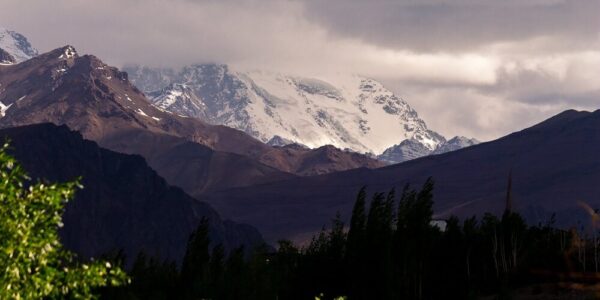Are small isolated communities like Ladakh a curse?
Till half a century ago, Ladakh was an isolated society with limited needs and aspirations. Dependent on agrifarming, life was hard with limited resources but self-sufficient and self-reliant with minimum intervention and interference from outside.
In comparison, contemporary Ladakh, with both physical and digital connectivity with the outside world, has developed more needs (goods, services, and ideas) and aspirations (such as carbon neutrality and tourism). These newly developed needs that the locals of Ladakh desire are challenging for the local population to fulfil independently, leading to a reliance on non-locals and outsiders. Consequently, Ladakh is forfeiting its self-reliant status.
My concern centres on this reliance on non-locals, opening the door for interference in Ladakh’s cultural and traditional societal systems. This compromises Ladakh’s cultural roots, as the adoption of non-local goods, services, and ideas may not align with the values of a good social scientist.
* Click to Follow Voice of Ladakh on WhatsApp *
Even isolated communities can’t suppress their desires in our rapidly changing world. Therefore, the other aspect of the problem is worth considering: why do we need to lean on others’ shoulders? The answer lies in our small population, incapable of producing a diverse range of professionals and service providers.
Ladakh’s small aboriginal population poses a dual challenge. Firstly, the lack of professionals and service providers hampers remote communities, resulting in issues highlighted by Surf Aid, an Australian NGO, such as limited access to healthcare, employment opportunities, infrastructure, internet access, and transport. Secondly, relying on non-locals erodes indigenous cultural roots and sometimes compromises service quality. Thus, I would frequently ask myself, Are small isolated communities like Ladakh a curse?
To ensure articulation and pick up these two points easily, I would take the example of a particular profession. Being a media person, journalism for instance, would be appropriate.
The first challenge is because of the small population, we don’t find sufficient students with a postgraduate or degree course in journalism. As we see, the DIPR, who paid a handsome stipend, did not find eligible students with a degree in journalism and thus had to change the eligibility criteria for contractual engagement to a master’s degree in Social Sciences. When there are no sufficient professionals, we face problems in coverage and documentation of daily developments in Ladakh.
As part of a leading local newspaper, we try to document all kinds of developments weekly. But in a geographically huge Ladakh extended from Zanskar to Kargil, Drass, Leh and Nubra, only a few could be documented with a limited perspective. The developments I miss in documentation due to lack of manpower concern me. But ironically, we also lack thinkers who could realise this gap.
In this situation, many of us are happy with the news reports published in National and sometimes international periodicals. I appreciate their efforts, concern and care for Ladakh, but seen from an outsider’s perspective and written by an outsider staying hundreds of kilometres away from the ground reflects little reality, which itself is a problem. Most of the works published outside are superficial and lack of depth. In some cases, we even saw lies and manipulation of news that were contrary to the ground reality.
Similarly, only local architecture could provide a better design considering the climate, lifestyle, culture, and other local preferences. An aboriginal doctor could better understand the ailments developed due to local lifestyle, food habits and topography. A local town planner could better suggest future development of villages and towns in Ladakh considering the agricultural, recreational, and festivity requirements while mitigating the risks of natural disasters. Similarly, all professions would have the same probability. The very purpose for which the Ladakh Autonomous Hill Development Council was established.
Despite this, the problem remains with us. Because we could not multiply the local indigenous population which does not seem a good decision considering the limited resources, but, in the long run, if we focus on diversity in education and opt for diverse professions, we could have a significant number of different professionals. But, till then, we could not leave the local populace without quality health care, better education, better infrastructure, internet access, transport, argumentative lawyers, quality journalists, and critical authors.
In a populated society and a well-off community, compromising a single journalist or few journalists would not make a difference. There would be many others who would document the events from different perspectives. But in a close society like ours, compromise or loss of a single professional could cause a huge loss, and a time span could go blank.
Similar is the case with other professions like medicine, education, architecture, engineering, art and craft, agriculture scientists, lawyers, politicians, town planners. Our duty is now “Al-wajib al-Kifai”, collective obligation that addresses no specific person and if some duty-bound person performs it, the others will no longer held accountable. But in our case, where the number is already short, it is only you who have the compulsion to perform it well. We don’t have the option to say, “why me?” because it’s only you in the field for the whole community. Just consider that you are the one who is created and born for that particular purpose, and there is no escape and no excuse.
In a nutshell, in the long run, we must focus on the creation of professionals in diverse fields and all walks of life. Additionally, we all must perform our duty sincerely and dedicatedly with visions high to ensure ease to the people living in this remote and isolated part of the globe. If you think and perform so, then small communities are not a curse, but if you don’t, they are!

0 Comments